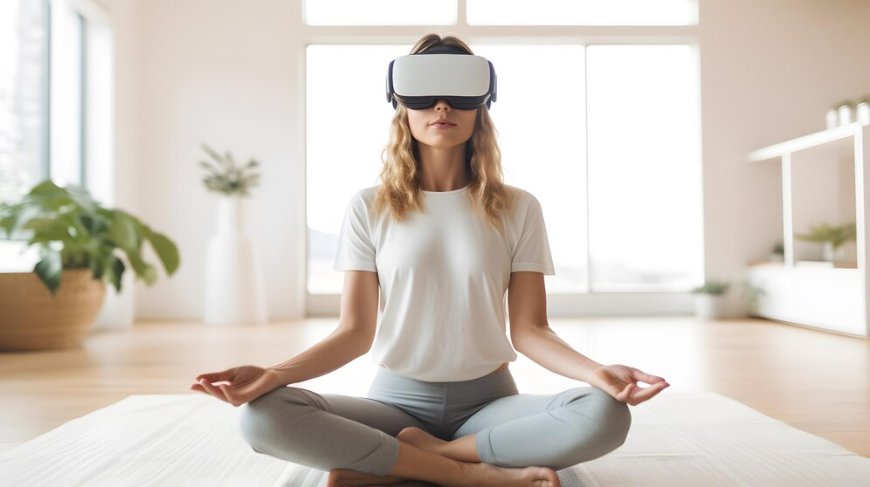Virtual Reality Meditation: Is This the Future of Mindfulness?
Virtual reality meditation is revolutionizing mindfulness. Learn how VR enhances relaxation, reduces stress, and improves focus with immersive meditation experiences.

How Technology is Revolutionizing the Way We Meditate
Imagine closing your eyes and finding yourself on a serene mountaintop, surrounded by flowing waterfalls, or floating in the middle of a tranquil ocean—all without leaving your living room. Virtual reality (VR) meditation is rapidly emerging as a groundbreaking way to practice mindfulness, offering immersive environments that help users relax, focus, and de-stress like never before.
With mental health concerns on the rise and people seeking innovative ways to unwind, VR meditation is gaining traction as a next-level mindfulness tool. But is it truly effective? And can it replace traditional meditation practices? This article explores the science behind VR meditation, its benefits, and what experts are saying about this tech-driven wellness trend.
What is Virtual Reality Meditation?
VR meditation combines traditional mindfulness techniques with immersive, 360-degree virtual environments, transporting users into calming, digitally created spaces that enhance relaxation and focus. Using VR headsets like the Meta Quest 3, HTC Vive, or PlayStation VR, individuals can engage in guided meditation sessions, deep-breathing exercises, and even biofeedback-enhanced mindfulness training.
Apps like Tripp VR (Tripp), Guided Meditation VR (Steam), and Hoame VR (Hoame) offer immersive meditation experiences designed to help users reach deep states of relaxation in minutes.
The Science Behind VR Meditation
Can Virtual Reality Enhance Mindfulness?
Research suggests that VR-based meditation can be just as effective, if not more so, than traditional meditation techniques. Studies indicate that immersive environments can:
- Reduce Stress and Anxiety – A 2023 study published in the Journal of Medical Internet Research (JMIR) found that participants using VR meditation experienced a 32 percent decrease in stress levels after just one 10-minute session.
- Improve Focus and Attention – According to Harvard Medical School (Harvard Health), mindfulness meditation has been shown to enhance cognitive function and attention span. VR adds a layer of engagement by eliminating distractions and keeping users deeply immersed.
- Encourage Consistency – Many people struggle with meditation because it requires discipline. VR gamifies the experience, making mindfulness more engaging and easier to practice regularly.
- Enhance Emotional Regulation – A study by Stanford University’s Virtual Human Interaction Lab (Stanford) found that virtual environments could help users develop greater emotional resilience and self-awareness.
Key Benefits of VR Meditation
A Fully Immersive Experience
Unlike traditional meditation, where distractions like background noise or wandering thoughts can break concentration, VR meditation blocks out the external world, creating a distraction-free environment that enhances focus.
Guided Meditation with AI and Biofeedback
New VR meditation apps incorporate AI-driven guided sessions and real-time biofeedback. Devices like the Muse Headband (Muse) track brain activity and provide personalized feedback, helping users deepen their practice.
Accessibility and Convenience
Not everyone can visit a meditation retreat, but with VR, anyone can access calming landscapes, expert-led mindfulness sessions, and stress-relief tools from home. This makes meditation more accessible to those who struggle with traditional methods.
Mental Health Applications
VR meditation is being used in therapy and mental health treatments for conditions like post-traumatic stress disorder (PTSD), anxiety, and depression. The Cleveland Clinic (Cleveland Clinic) has incorporated VR mindfulness training into its mental wellness programs, reporting significant improvements in patients’ emotional well-being.
How to Get Started with VR Meditation
Step 1: Choose the Right VR Headset
To experience VR meditation, you will need a compatible headset. Some of the best options include:
- Meta Quest 3 – Wireless, standalone headset with access to a wide range of meditation apps.
- HTC Vive XR Elite – High-end option for a more immersive experience.
- PlayStation VR2 – Ideal for those who already own a PlayStation console.
- Oculus Rift S – Great for PC-based VR applications.
Step 2: Select a Meditation App
There are several high-quality VR meditation apps available, including:
- Tripp VR (Tripp) – Uses psychedelic-inspired visuals and guided meditation techniques.
- Guided Meditation VR (Steam) – Offers a vast selection of serene environments and audio guidance.
- Hoame VR (Hoame) – Focuses on stress relief and mindfulness techniques.
Step 3: Set Up Your Meditation Space
To enhance your experience, find a quiet, comfortable space where you will not be disturbed. Dim the lights, wear comfortable clothing, and ensure your headset is fully charged.
Step 4: Start with Short Sessions
If you are new to meditation, begin with five- to ten-minute sessions. Over time, you can gradually increase your practice as you become more comfortable with the technology.
The Future of VR Meditation: A Digital Revolution in Wellness?
Virtual reality is transforming meditation from a passive activity into an immersive, multi-sensory experience. As technology advances, there may soon be AI-driven mindfulness coaches, brainwave-adaptive meditation programs, and even VR-based spiritual retreats.
With the rise of stress-related health issues worldwide, the need for innovative relaxation methods is greater than ever. While traditional meditation will always have its place, VR meditation is making mindfulness more accessible, engaging, and effective for a tech-savvy generation.
For those looking to reduce stress, improve focus, and enhance emotional well-being, VR meditation may just be the future of mindfulness.
What's Your Reaction?
 Like
0
Like
0
 Dislike
0
Dislike
0
 Love
0
Love
0
 Funny
0
Funny
0
 Angry
0
Angry
0
 Sad
0
Sad
0
 Wow
0
Wow
0



















































